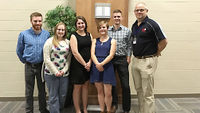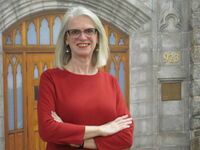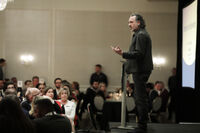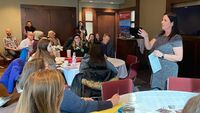By Jordan Whitehouse |
Seven years ago, it looked like Kyle Awalt was just hitting his stride as a software developer. He’d graduated from Acadia University in 2008 with a degree in Computer Science, and now he was back on the East Coast after a stint with BlackBerry during its peak years.
But something was missing. Even at a new software job at NTT Data in Halifax, things weren’t feeling as rewarding or as mentally stimulating as he thought they should (there was also a lot of sitting). He needed a change. He thought back to his days of growing up in Fall River, Nova Scotia, and more specifically to those high-school Chemistry classes he really enjoyed. The idea caught.
“What I found attractive about Chemistry, and specifically medicinal Chemistry, was that it didn’t seem such a stretch to imagine my work having an impact on people's lives,” he says.
Fast forward seven years, and his imaginings weren’t far from reality. Kyle is now in Melbourne, Australia, pursuing a PhD in medicinal Chemistry at the Monash Institute of Pharmaceutical Sciences (MIPS). It’s considered one of the top schools in the world for pharmacology. His current research is focused on finding a drug that can offer cardiovascular protection during episodes of ischemia and reperfusion injury (i.e. heart attacks).
But let’s back up to 2014, when Kyle began pursuing his Bachelor of Science in Chemistry at Saint Mary’s University.
Back then he still had a toe in the digital world, still working part-time at that software job in Halifax. That all changed, however, during the second semester of his second year, when he approached Chemistry professor Dr. Robert Singer about joining his research group, and got in. “After that, I decided to leave the job and focus on school full time,” he says. “I loved the research and put in a lot of work over the next two years, publishing two papers with Dr. Singer.”
That research and those papers were related to alkaloids. The idea, says Kyle, was to improve the process of manufacturing synthetic opioids, like Naloxone, which is a medication used to block the effects of narcotics, especially during overdoses. More specifically, Kyle and his co-authors were trying to make one step of the multi-step synthesis of those opioids more efficient.
One of the co-authors on those papers was Dr. Peter Scammells, a professor and “theme leader” of medicinal Chemistry at MIPS in Australia. He and Dr. Singer have known each other since their post-doc days in Germany.
“When I first got into doing research with Rob [Singer], he asked me what I was interested in and I mentioned medicinal Chemistry,” remembers Kyle. “I think he had the idea right away that I might be able to pursue a PhD at Monash if I wanted, and if I could get in [the biggest requirement was publishing a paper first].”
Given Kyle’s interest in medicinal Chemistry and the reputation of the school, he definitely did want to pursue it. Last year, and for the second year in a row, Monash University ranked second in the world for pharmacy and pharmacology by QS World University Rankings. “It was an easy choice,” says Kyle.
Two years into the four-year PhD program, he continues to develop a drug that, when injected into a patient during a heart attack, would limit cell death in the heart. His main job is to perform a study which reveals the relationship between the molecular structure of the drugs and the physiological responses they elicit.
Most of his time right now is spent in a Chemistry lab synthesizing the drug candidates. The rest is in a pharmacology lab performing in-vitro tests on cells that have been removed from any biological context. These tests act as initial, easy-to-perform screenings that can tell him if a drug candidate shows promise to go to other types of testing, such as on animal subjects.
Saint Mary’s Kaitlyn Blatt-Janmaat joined Kyle in that lab for a few months last fall. The soon-to-be Honours Chemistry grad was there to help speed up the synthesis of one part of a drug candidate and use safer reagents in the process. When she got there, the synthesis took 1.5 to 2 days. By the time she left in December, she had gotten it down to four hours. “It basically means that making that part of the molecule can be done faster and safer than previously, which makes life easier for anyone else working on it, mainly Kyle,” she explains.
Kaitlyn was at MIPS on a Mitacs Globalink Research Award. It provides $6,000 to undergrads, graduate students, and postdoctoral fellows in Canada to do research projects at universities overseas. Kaitlyn was the first ever Saint Mary’s student to get one of these awards.
Overall, she says her experience at MIPS was “absolutely beneficial,” one big reason being her working relationship with Kyle. “He’s a fantastic guy to work with,” says Kaitlyn. “He’s one of the most hard-working people I’ve ever met, quite frankly. He works really long hours, and he loves what he does.”
This December Kyle will head to the University of Nottingham in the UK for a year. He’ll continue his research on the heart drug, and then return to MIPS for a fourth and final year to finish the project and write his thesis.
A post-doc will likely be next, but his ultimate goal is to secure a faculty position at a university and start his own research group. “I think I would prefer to be at a school in Australia or Canada, but beggars can’t be choosers!”
Looking back, he says that his choice to get fully out of software development and into Dr. Singer’s Chemistry lab at Saint Mary’s was one the best he’s ever made. “Rob gives his students a lot of freedom in the lab which allows them to learn from their own mistakes and take ownership of their work,” says Kyle. “I think this independence above all else was how I got to where I am now.”




